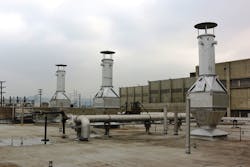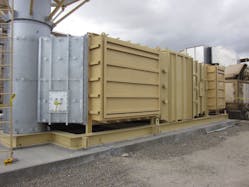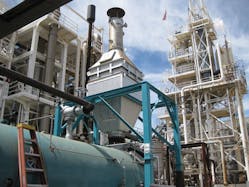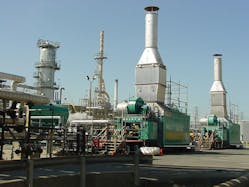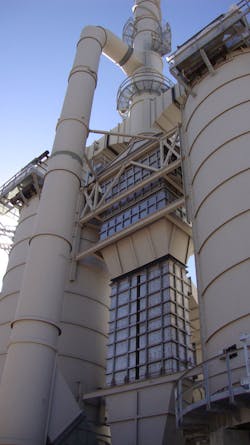When it comes to emissions control, big business has moved beyond the question of why, as companies that produce electricity, food, and paper, among other essential goods, are interested in being good corporate citizens. While the validity of allowable criteria emissions may forever be debated, the same no longer can be said of the need to minimize pollution. Still, when pollution-control equipment is needed, it should be designed and implemented in such a way as to minimize the impact on revenue-generating processes. This article will discuss factors owners should consider when purchasing nitrogen-oxide- (NOx-) control technology, a selective-catalytic-reduction (SCR) system in particular.
Choosing the Right Equipment
If you purchased your boiler to produce steam at a given pressure and are looking to reduce emissions, it is not practical to derate the boiler or impact the efficiency of the boiler by adding an oversized flue-gas-recirculation (FGR) fan and installing an ultralow-NOx burner that is temperamental during load changes.
A back-end SCR system—defined as a section of ductwork downstream of fired equipment, such as a boiler, heater, or gas turbine, just prior to the exhaust stack—reduces NOx emissions with minimal impact on boiler efficiency and auxiliary load. Frequently, an economizer is used for increased process efficiency. In such cases, a SCR system ideally would be located upstream of the economizer to take advantage of hotter exhaust-gas temperatures (the catalyst is more reactive at hotter temperatures). Back-end SCR systems operate effectively in the 300°F-to-850°F range without additional equipment for managing flow or higher temperatures.
In a SCR system, a reagent is injected into the exhaust duct upstream of the catalyst face. The reagent is distributed across the exhaust duct and mixed in the direction of exhaust flow with NOx molecules generated by combustion. It flows over a catalyst and is converted to inert products—namely, nitrogen and water. Although the process occurs naturally at temperatures of 1,600°F to 2,500°F, in highly successful back-end solutions, a catalyst is used for higher-efficiency reduction and better control.
With fired equipment, there is a slight pressure drop across the catalyst. In a majority of tail-end systems, pressure drop is designed to be 1 in. wc to 2 in. wc. In the case of retrofits in which existing fans may not support much additional pressure drop, a sub-1-in.-wc system can be designed. In larger systems, ones typically seen in refineries, a small induced-draft fan can be added to prevent boiler-capacity loss.
Typically, the reagent in a SCR system is ammonia—either anhydrous, which effectively is pure ammonia, or aqueous, which is ammonia diluted with water to a concentration of 29 percent or 19 percent, depending on what the end user would like to handle—or urea. Urea decomposes into ammonia with the addition of heat and is delivered to the catalyst face. The auxiliary load for an aqueous-ammonia solution or a urea solution is slightly higher than that for an anhydrous-ammonia solution because of the evaporation of the water or the conversion of the urea.
What Owners Need to Know
The amount of ammonia required for a SCR system is just over 1:1 mole ratio of NOx to be reduced. NOx to be reduced is measured in parts per million (ppm). At these levels, ammonia flow can be as low as 1 lb per hour or less. Critical design criteria require the dilution distribution across ducts during operation to be such that each ppm of NOx meet the corresponding ppm of ammonia at the catalyst surface. The need for precise mixing could be the difference between passing and failing an emissions test. Physical factors in upstream ductwork and heating surfaces make altering system design based on flow velocity and temperature gradients necessary.
A tight seal around the catalyst is required to ensure exhaust does not get past the reaction space. For this, the orientation of the reactors must be evaluated. Sealing systems for vertical reactors differ from those for horizontal ones. In a vertical reactor, gravity does most of the work, and thermal expansion is taken care of in one plane. In a horizontal reactor, thermal growth must be considered in two planes, with the sliding metal providing the seal and support. Overall, when a system is operating in the sub-9-ppm-of-NOx range, the operators must ensure the system is not using additional reagent to compensate for bypass NOx, indicated by elevated ammonia “slip”—unreacted ammonia that passes through the stack—with no corresponding reduction in NOx.
System Performance
A SCR system is controlled by a fuel signal that converts flow to a NOx level to which the reagent control valve reacts. This maintains the given relationship between expected NOx in the exhaust gas and the amount of reagent diluted and injected into the ductwork. In some systems, when a stack-monitoring component is employed, the control system will take a feedback signal from the stack and trim the control valve to better hone in on the set point. Control systems with feed-forward and feedback loops manage load swings and fuel variations automatically and almost immediately minimize any hunting, allowing the system to remain in compliance.
SCR-system performance is measured in tons of NOx reduced per year. Systems commonly are designed to reduce combustion-generated NOx by more than 85 percent, while many are designed to reduce it by more than 90 percent, with outlet levels of NOx as low as 2 ppm.
Ammonia slip typically is limited to 10 ppm or less and determined based on individual state implementation plans. Major differences in requirements based on equipment categorized as major source or area source exist. Major sources generate more than 10 tons of any one criteria pollutant or more than 25 tons of a combination of pollutants in a year.
What to Expect From a SCR System
A SCR system will perform throughout the design life of its catalyst. Typically, the design criterion for a catalyst is three to five years. While catalyst is not consumed during the chemical process, constituents in exhaust gas, along with dust and other particles, may cause degradation in performance beyond the warranted life. At such a time, the catalyst should be replaced. Other than that, there are no wear components. For operation to be maximized, maintenance must be performed on fans, valves, and other parts.
Summary
A SCR system eliminates the need to use ultralow-NOx burners with overly complex controls, high excess-oxygen levels, large combustion-blower motors, and high-maintenance FGR systems and allows fired equipment to perform as intended. It increases the efficiency of specified equipment (boilers, heaters, etc.) while utilizing more conventional user-friendly burners and burner control systems. A SCR system allows specified equipment to follow plant load more accurately by providing a higher turndown rate (greater than 10:1) and faster modulation ramp speeds while maintaining predictable and repeatable performance.
Sean McMenamin is director of environmental solutions for Nationwide Environmental Solutions, a strategic business unit of Nationwide Boiler Inc. He has over 13 years of experience with selective-catalytic-reduction and air-pollution equipment, as well as five years of experience with utility steam generators.
Did you find this article useful? Send comments and suggestions to Executive Editor Scott Arnold at [email protected].










